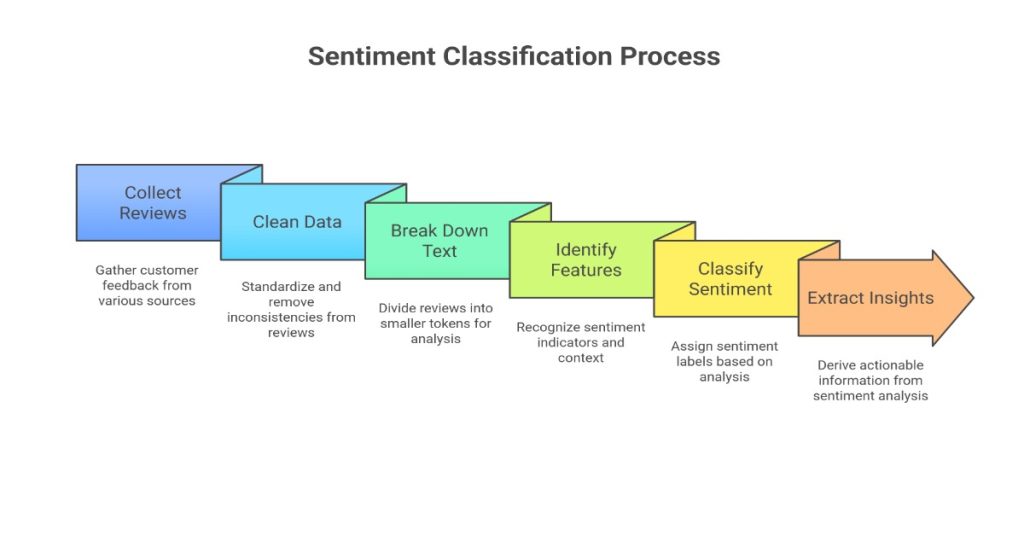You’re an ecommerce business owner, and you’ve just received hundreds of customer reviews for your products. Some are glowing. Others are critical. A few are downright confusing customers seem happy about your product, but their words suggest otherwise.
You’re sitting there wondering: how do I make sense of all this feedback quickly? How do I know which reviews actually matter? And most importantly, how do I fix problems my customers are experiencing?
This is where sentiment classification comes in, and it’s a game-changer for your business.
Table of Contents
The Problem You’re Facing Right Now
Let’s be honest. Manually reading through hundreds or thousands of reviews is exhausting. You’re paying someone (or doing it yourself) to sort through comments, trying to figure out which ones are positive, negative, or neutral. This costs time, money, and energy—resources your business desperately needs elsewhere.
But here’s the real problem: when you miss important feedback, you miss the chance to improve. A customer complaining about product quality, slow delivery, or poor packaging might just click away and leave a bad review instead of telling you directly. That feedback could have saved your reputation and boosted your sales.
Sentiment classification is the solution to this headache. It’s a technique that automatically analyzes customer reviews and categorizes them by emotion and intent. Instead of spending hours reading reviews, your system does it for you—instantly and accurately.

What Is Sentiment Classification, Anyway?
Think of sentiment classification as teaching a computer to understand feelings and opinions the way humans do.
In simple terms, it’s a process where artificial intelligence reads text (in this case, your customer reviews) and determines whether the overall emotion is positive, negative, or neutral. Some advanced systems even go deeper and identify mixed sentiments or specific emotions like frustration, joy, or disappointment.
Here’s a quick example:
- This product is amazing! Best purchase ever. → Positive
- The quality is terrible and it broke after two days. → Negative
- It arrived on time. → Neutral
But what makes it powerful for ecommerce is that it does this for thousands of reviews in seconds. Imagine having a team member who never sleeps, never gets tired, and can process feedback faster than you can blink. That’s essentially what sentiment classification gives you.
Why Should You Actually Care?
You might be thinking: “This sounds interesting, but why do I need it?” Here’s why it matters for your bottom line.
Finding Real Problems Before They Cost You Sales
Negative reviews buried in your product page can hurt your sales more than you realize. By automatically identifying negative sentiment, you can spot problems with specific products, shipping processes, or customer service. Then you can actually fix them instead of letting them fester.
Making Data-Driven Decisions
Positive reviews aren’t just ego boosts. They’re goldmines of information. By classifying positive sentiment, you can identify what’s working and replicate it. Maybe customers love your packaging. Maybe they appreciate your fast shipping. Sentiment classification helps you double down on what works.

Understanding What Your Customers Really Love
Instead of gut feelings, you get facts. You’ll know exactly what percentage of reviews are negative, what specific issues customers mention most, and where to focus your improvement efforts. This is powerful information for prioritizing your business decisions.
Saving Money and Time
One person could spend 8 hours a day just reading reviews. Sentiment classification does this instantly. You’re not replacing humans entirely, but you’re making them much more effective by letting them focus on strategic decisions rather than data entry.
How Sentiment Classification Works (Without the Jargon)
Let’s break this down into pieces so you understand what’s actually happening.
Step 1: Collect Your Reviews
First, you gather all your customer feedback. This comes from your website, Amazon, review sites, email feedback—anywhere customers share their thoughts about your products.
Step 2: Clean the Data
Raw customer feedback is messy. People type quickly, make typos, use emojis, and sometimes speak in abbreviations. Before your system can analyze it, you need to clean this data. Remove extra spaces, standardize text, and handle things like emojis and special characters.
Step 3: Break Down the Text
The system breaks each review into smaller pieces (called “tokens”) so it can understand the structure. It identifies words, phrases, and how they relate to each other.
Step 4: Identify Key Features and Emotions
Now comes the interesting part. The system looks for words and phrases that indicate emotion or opinion. Words like “love,” “hate,” “amazing,” “disappointing,” “broken,” “perfect”—these are sentiment indicators. It also looks for context. For example, “not good” means something different than just “good.”
Step 5: Classify the Sentiment
Based on everything it found, the system assigns a sentiment label. Is it positive, negative, or neutral? Some systems even give it a confidence score—how sure is the system about its classification?
Step 6: Extract Actionable Insights
The final step is turning this analysis into something useful. Which products have the most negative reviews? What specific complaints come up repeatedly? This information becomes your action plan.

Different Types of Sentiment Classification
Not all sentiment analysis is created equal. Here are the main approaches:
Rule-Based Classification
This is the simplest approach. You create rules. If a review contains the word “X,” it’s negative. If it contains the word “Y,” it’s positive. It’s fast and straightforward, but it’s not very smart. It misses context and can’t handle sarcasm or complex opinions.
Machine Learning Classification
Here, you feed the system thousands of pre-labeled reviews (reviews that humans have already categorized as positive, negative, or neutral). The system learns patterns from these examples and applies what it learned to new reviews. It’s much more accurate than rule-based systems and understands context better.
Deep Learning Classification
This uses advanced neural networks that can understand language at a deeper level. It’s the most sophisticated approach and handles sarcasm, multiple sentiments in one review, and nuanced language. The trade-off? It’s more complex to set up and requires more computing power.
For most ecommerce businesses, machine learning classification hits the sweet spot between accuracy and practicality.
Getting Started With Sentiment Classification
You don’t need to be a data scientist to implement this. Here’s how to get started:
Choose Your Tools
Several platforms make this easier. Tools like Google Cloud Natural Language, Amazon Comprehend, or IBM Watson offer sentiment analysis as a service. You can also use Python libraries like TextBlob or VADER if you have a technical team. Many ecommerce platforms also have built-in sentiment analysis features.
Feed It Your Data
Connect your review data to your chosen tool. This could mean exporting reviews from your website, connecting directly to your product pages, or pulling from review platforms.
Set Your Categories
Decide what you want to measure. Simple positive/negative/neutral? Or do you want to dig deeper and identify specific emotions or product aspects?
Analyze and Act
Once the system processes your reviews, look at the results. Identify trends. Find products with concerning negative sentiment. Spot the features customers love most. Then use this information to make decisions.

Real-World Example You Can Relate To
Let’s say you sell athletic shoes online. You run sentiment classification on 500 recent reviews and discover:
- 70% are positive
- 20% are negative
- 10% are neutral
But when you dig deeper, you notice something important: 15 negative reviews mention “sizing runs small.” That’s information gold. Now you know you need to update your size guide, maybe add more size options, or address this in your product description. You prevent future negative reviews by solving a real problem.
Without sentiment classification, these 15 reviews could get lost in the noise. With it, they become your roadmap for improvement.
Common Challenges and How to Handle Them
Mixed Sentiments
Sometimes a review says: “The product is great, but shipping took forever.” This is both positive and negative. Good sentiment systems can handle this by giving different scores to different aspects. This is called aspect-based sentiment analysis, and it’s incredibly useful for ecommerce.
Sarcasm and Context
“Oh, excellent job on the defective product!” looks positive at first glance. But it’s clearly sarcastic. Advanced systems catch this by understanding context, but simpler systems might miss it. This is why machine learning and deep learning approaches work better than rule-based systems.
Multiple Languages
If you sell internationally, you’ll get reviews in different languages. Some tools handle multiple languages well, while others need separate models for each language. Check your tool’s capabilities before committing.
Read More
Survey Distribution Methods: Online vs Offline Questionnaires | Which One Works Best?
Get Paid for Your Opinion: Top Trustworthy Survey Sites
Improving Communication: A Practical Guide to Online Employee Surveys
Moving Forward
Sentiment classification isn’t just a fancy tech feature. It’s a practical tool that helps you understand your customers better and make smarter business decisions. You’ll save time, catch problems before they damage your reputation, and identify opportunities to improve your products and services.
Start small. Pick one product or a small batch of reviews. Run sentiment analysis on them and see what insights you uncover. Then expand from there.
Your customers are already telling you what they think. Sentiment classification just helps you listen better.

